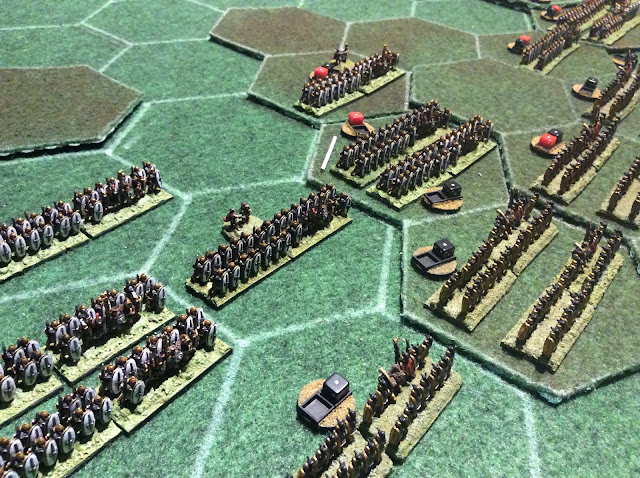The Pompeian forces did however have quite literally a card up their sleeve, played as their movement card it allowed 'Move one group, all attacking blocks fire before all defending blocks in any one battle, one round only'. Now if you recall one round in the battles fought in the boardgame equates to three turns or 1/4 of the twelve turn battle being fought on the table top.
So the question was how do I represent this advantage for the Pompeian force for these first three turns using the To the Strongest rules?
I decided that the Caesarian army would deploy first, particularly as they had no cavalry and were therefore out scouted. The Pompeian force could start the battle three full hexes in from their side of the table, they would get the first move free with no Caesarian reply and that the Pompeian force would for the first three turns only be graded on step higher than they actually were. So in this instance they were all raw but for the first three turns would fight as average troops and revert to raw on turn four.
The forces involved.
Neal came over and decided to take command of the Pompeian forces which set up as above, each side had two attached generals but notably no detached commander figure as no named commander was included in the forces on the campaign board. This was quite interesting as it limited the command distances on the tabletop considerably making each of us attempt to keep our forces concentrated.
As can be seen, the Pompeian force weighted it's right and pressed forward immediately attempting to take advantage of it's heightened moral for the first quarter of the battle.
The white shielded Pompeian legions move quickly forward.
Both forces push forward with their right wings. As usual the black die show that the units have thrown their pilum while the red die mark units disrupted, two of those and the unit is destroyed forcing a moral test on all surrounding units.
Pompeian forces on the right of the picture and Caesarian on the left. Note how outnumbered the Pompeian legions are, three to five, can they punch through the experienced Caesarian troops before the Pompeian cavalry on their left give way?
Units were beginning to give way but more on the Caesarian side, incredibly the inspired Pompeian troops were grinding their way through their opposite numbers, a grisly business! There weren't many token counters left in the Pompeian camp.
As the Caesarian commander I now had my chance to save this disaster, hit the centre in their flank and force Neal's cavalry off the field. Would the cards help me out - would they bollocks, attacks went in, attacks were repulsed, it must be a cards thing but we both swear like troopers when we play these rules, great stuff!
The end came when a couple of my Caesarian legionary units fled from the field and my last coin tokens went into the cup. A great game and a hard fought battle with credit going to Neal for forcing his troops forward utilising his temporary moral advantage and surprise advance. All of his legionary units were raw compared to the majority of mine which were average and veteran, a famous and unexpected victory to Caesar.
The disparity of casualties can be seen above, Caesarian top, Pompeian below, note that the marker blocks have been adjusted to show the strength point losses incurred because of the battle.
The situation on the map after the battle. The winning Pompeian force has occupied Narbo while the Caesarian forces have divided, two legions going to Burdigala (Bordeaux) and three to Massilia (Marseilles). The green block at the bottom of the picture should be in Tarraco.
Next will be a fighting retreat from Napolis by Pompey himself.
See you soon,
Dave.


















































